Item Reference: 006632
Category: Lantern Slides
Format: Slide
Description: Labelled as slide no. 55: A Map showing the British lines on the Western Front as of Spring 1918
Date: 1914-1918
Further Information:
Links:

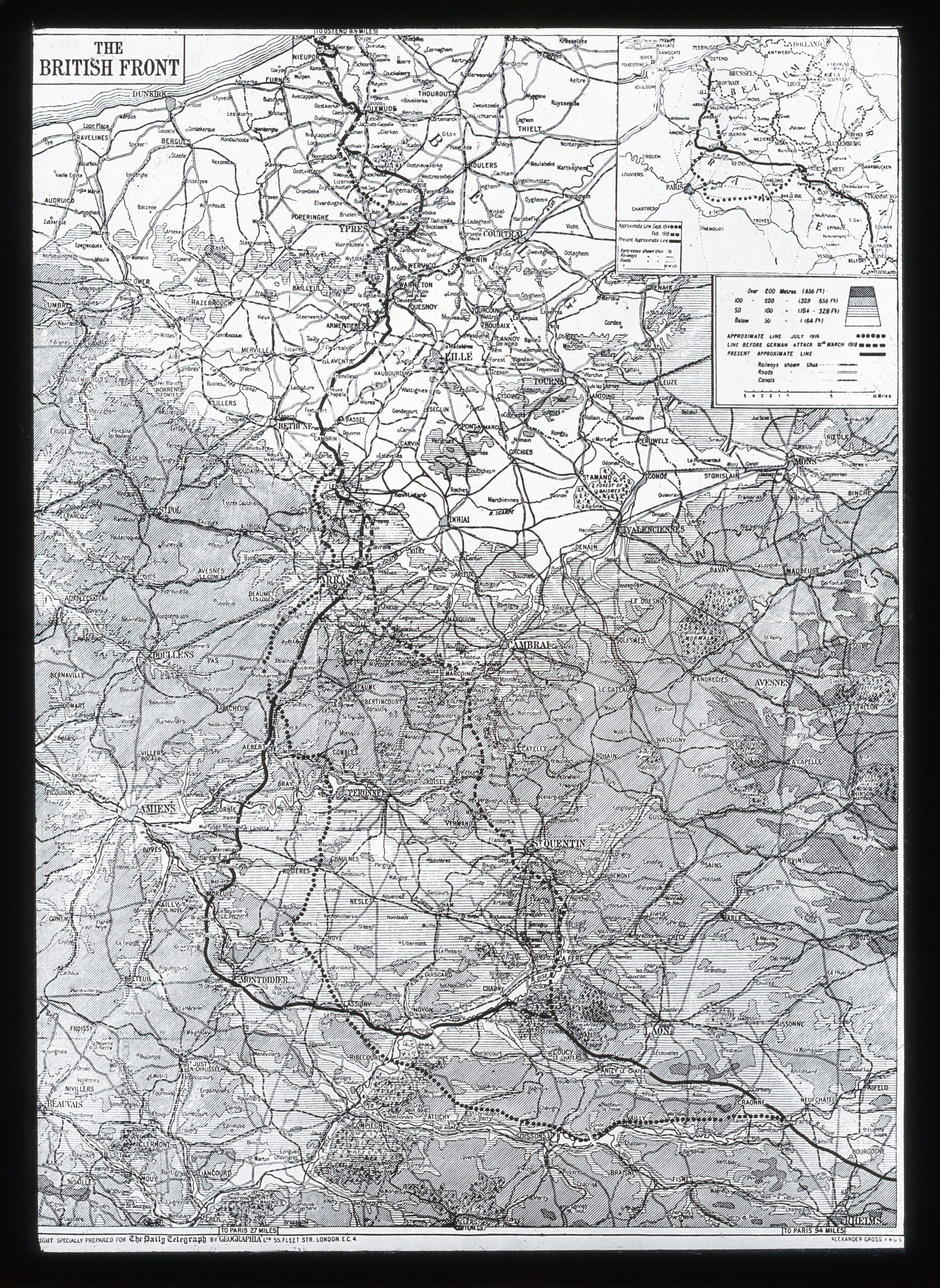
Item Reference: 006600
Category: First World War
Format: Postcard
Description: 5 Postcards featuring art by Bruce Bairnsfather including his most famous character ‘Old Bill’. All feature an SRD Rum Jar.
Date: 1914-1918
Further Information: All feature an SRD Rum Jar, one of which we have in the collection.
Links:

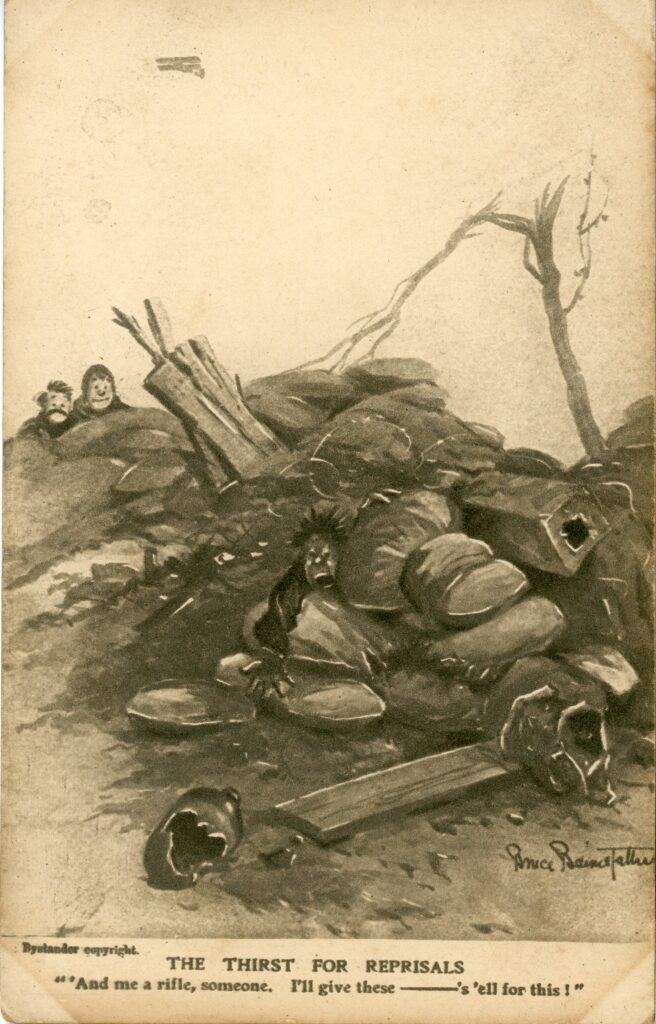



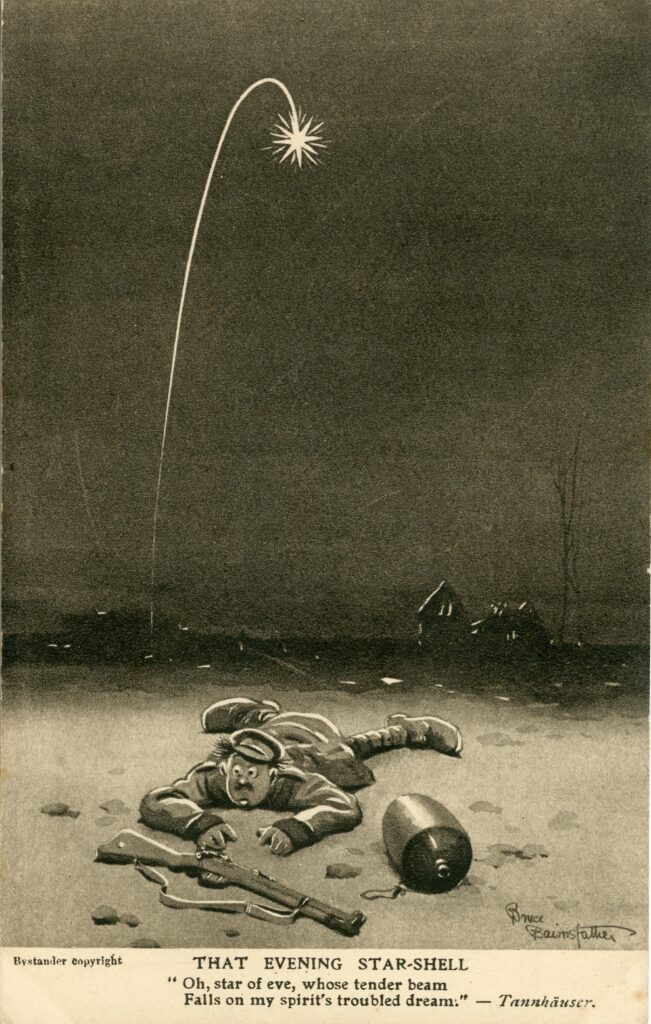
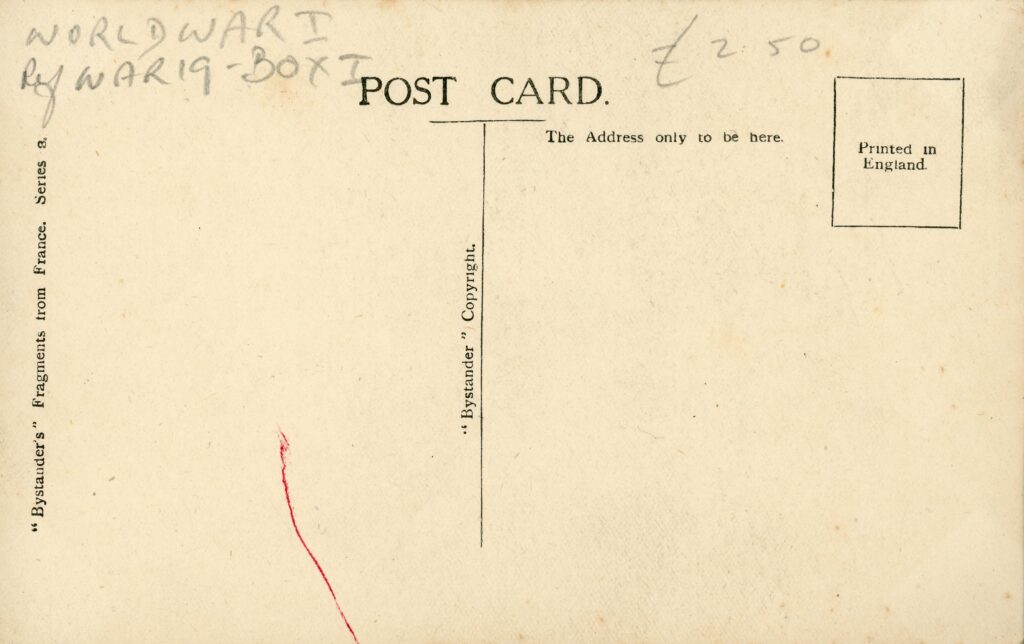
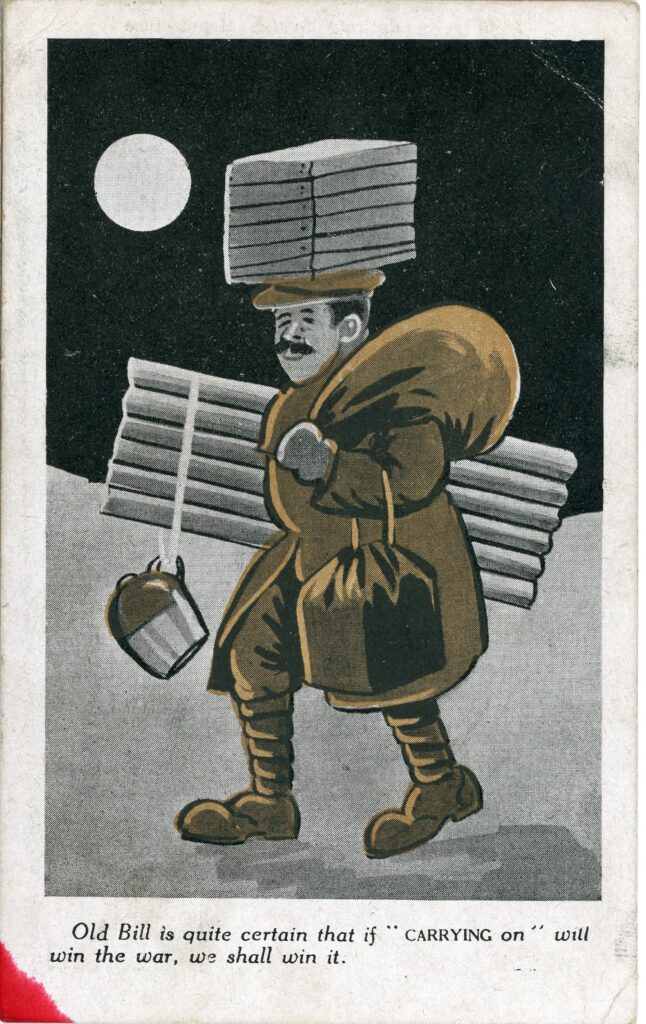
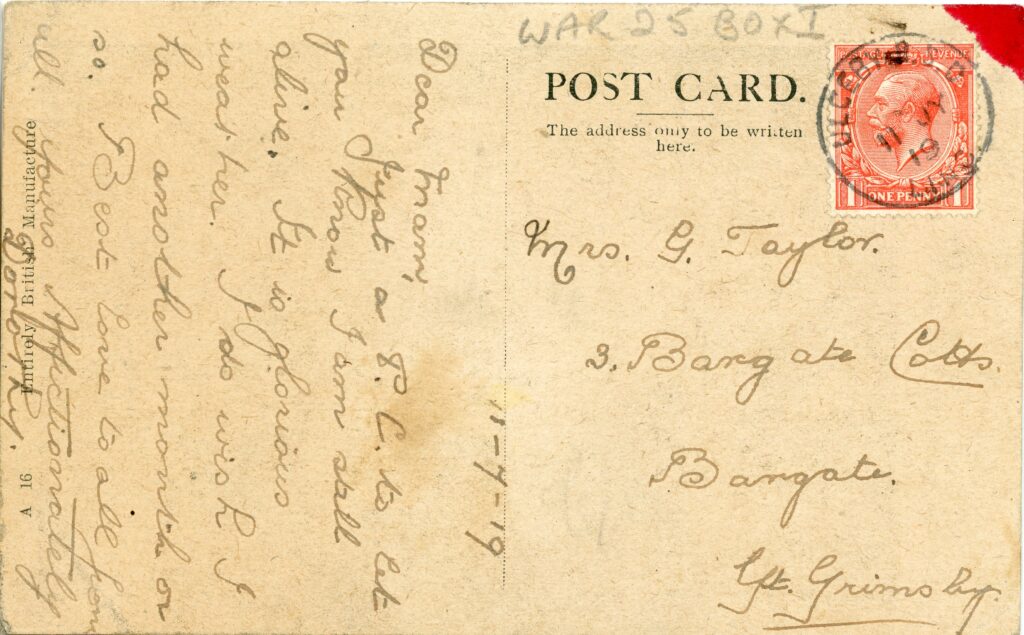
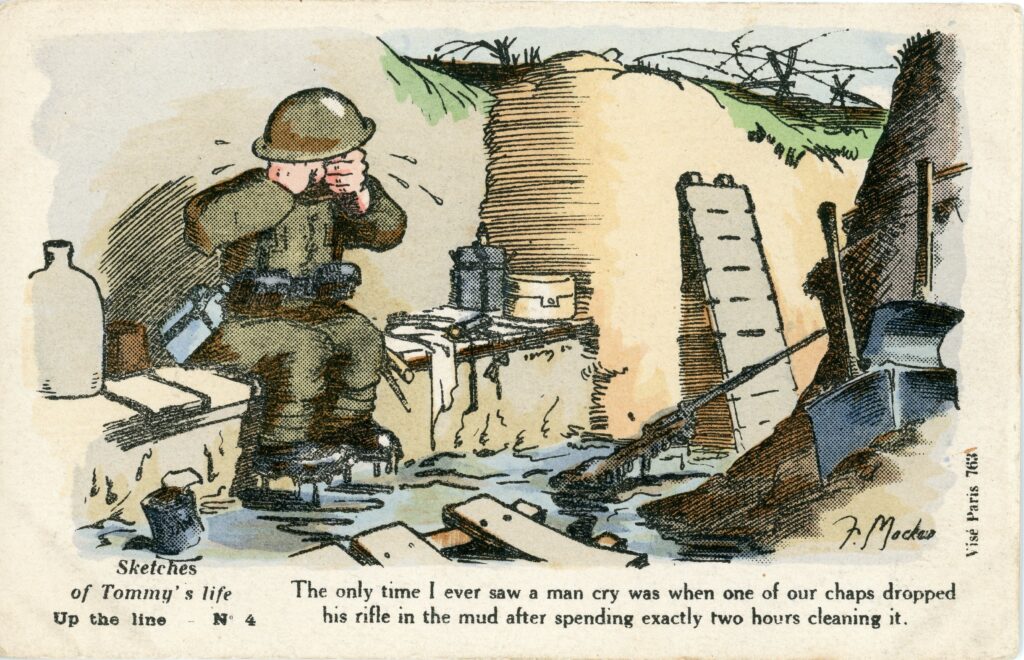

Item Reference: 006599
Category: First World War
Format: Artefact
Description: A 2-panel decorative sign for Lewisham London Military Hospital, with carved words on the reverse.
Date: 1914-1918
Further Information:
Links:
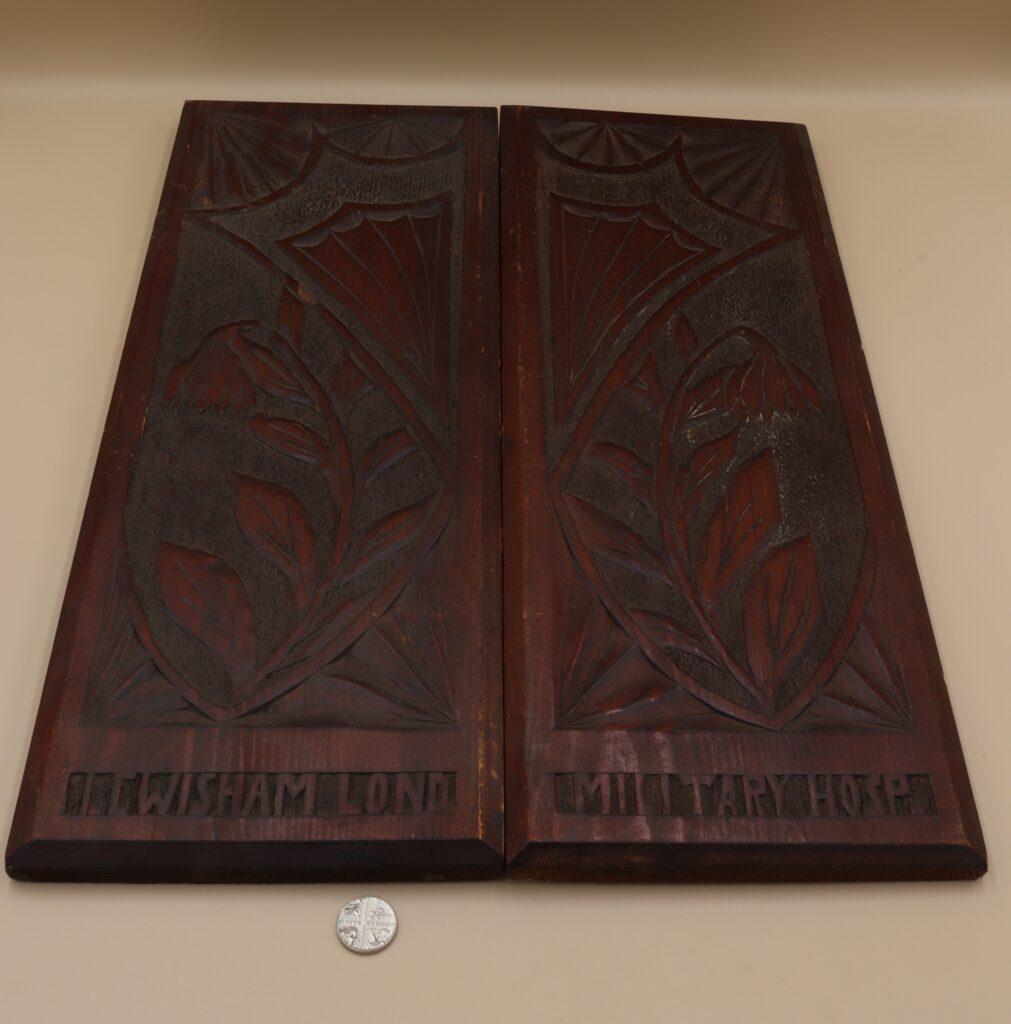
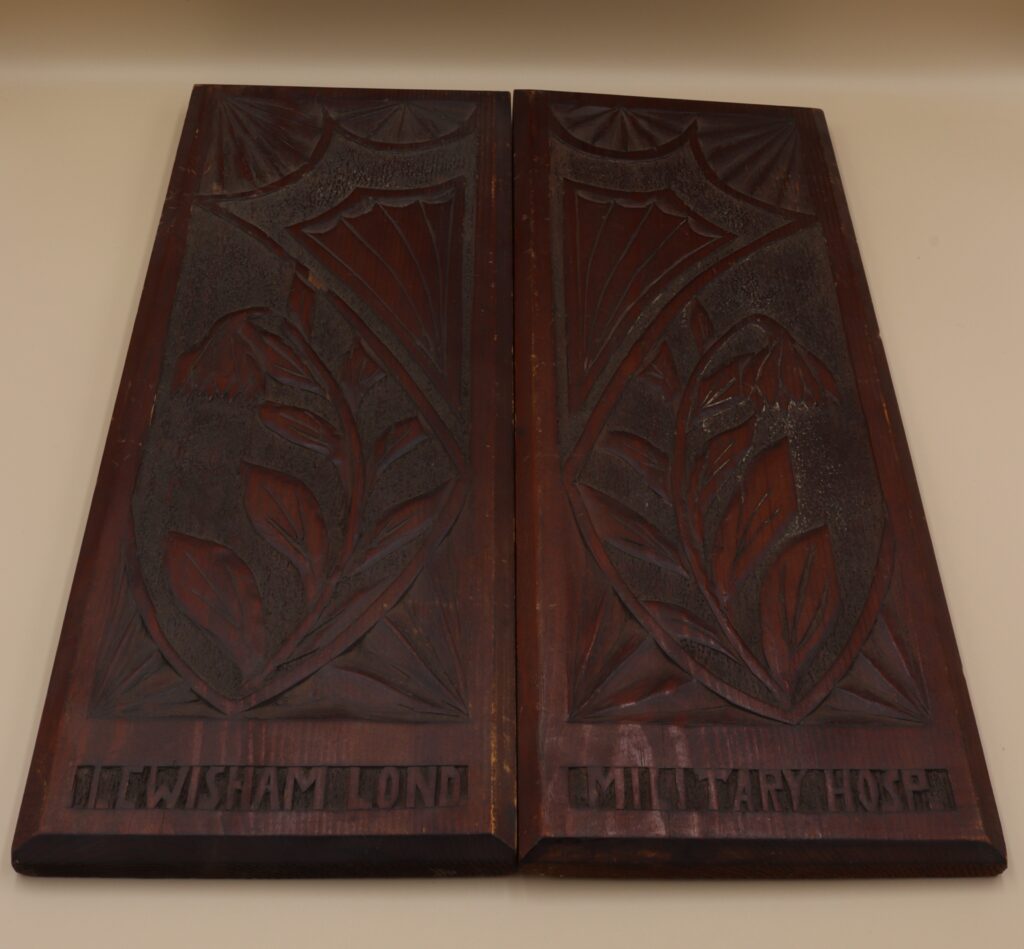
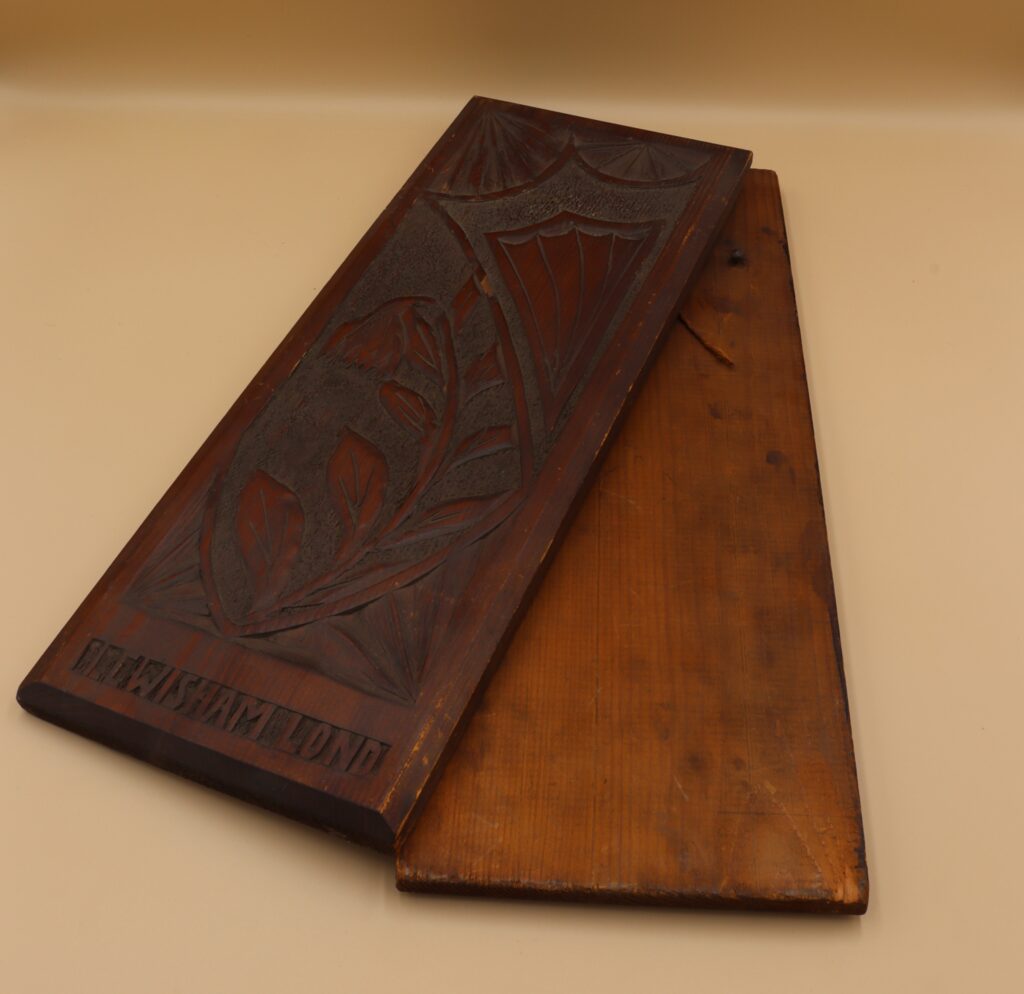
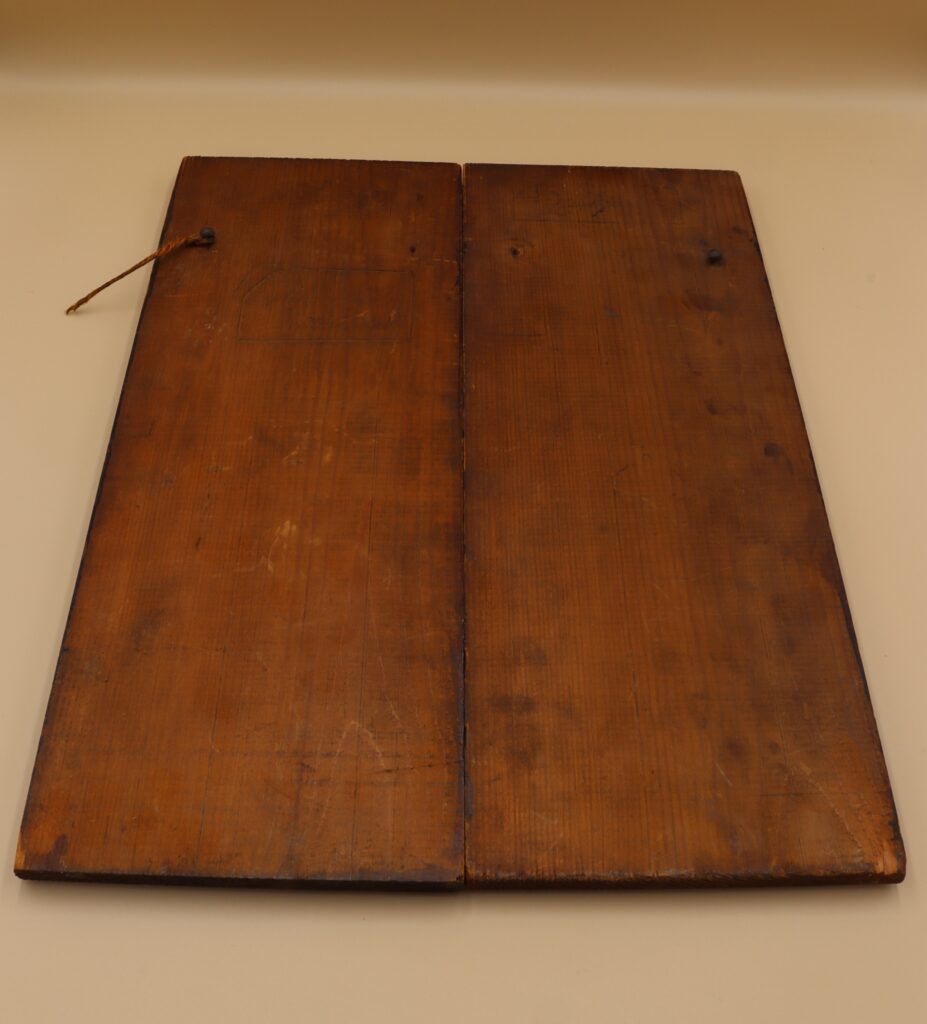
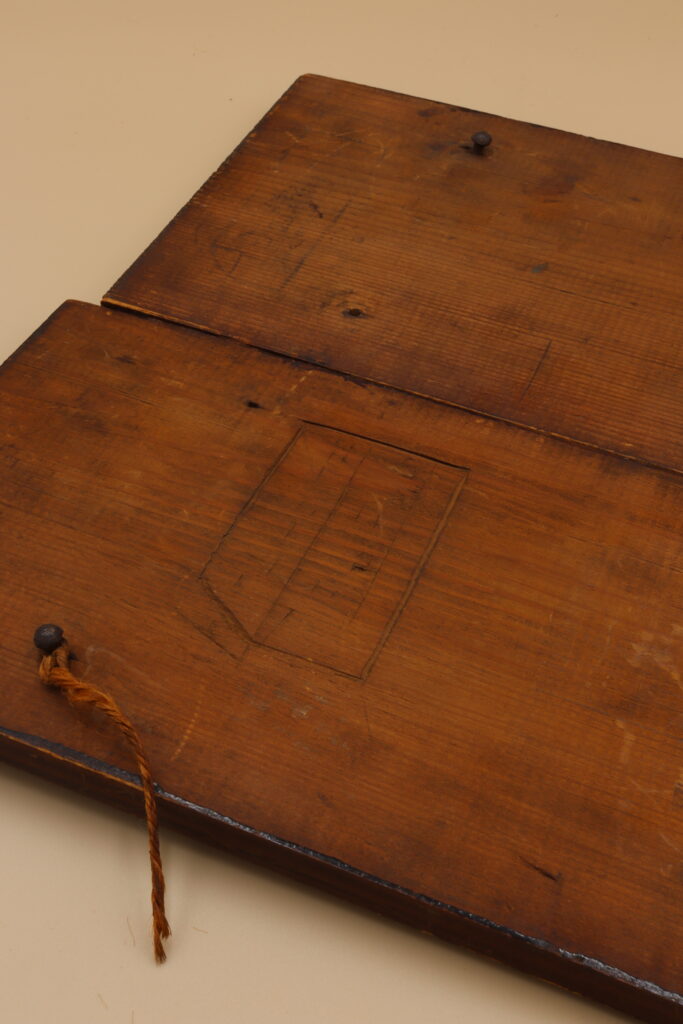
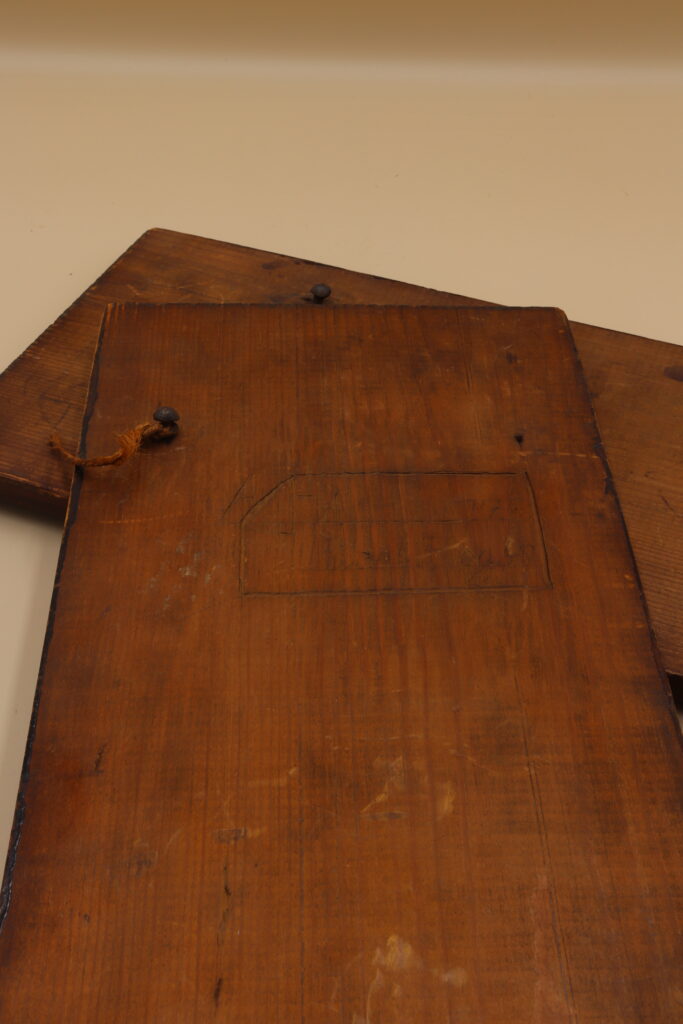
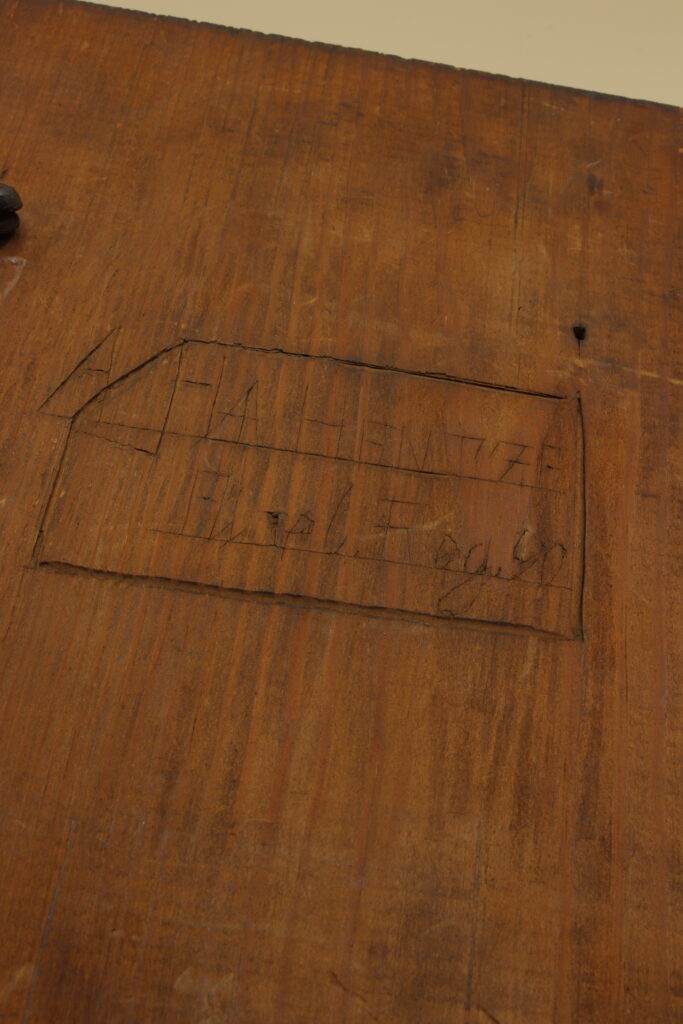
Item Reference: 001510
Category: First World War
Format: Artefact
Description: Earthenware rum jar marked ‘SRD’ for Supply Reserve Depot, though many soldiers joked it stood for ‘soon runs dry’
Date: 1914-1918
Further Information: Label on the base suggests it was produced in Chesterfield, though there was a large Supply Reserve Depot in Deptford Dockyard commandeered for military use at the outbreak of the Great War. It remained a large military supply depot until 1984, when the dockyard shut and became Convoys Wharf.
Links: Info under section ‘Supply Reserve Depot’, see postcards featuring trench art of the ubiquitous rum jar.
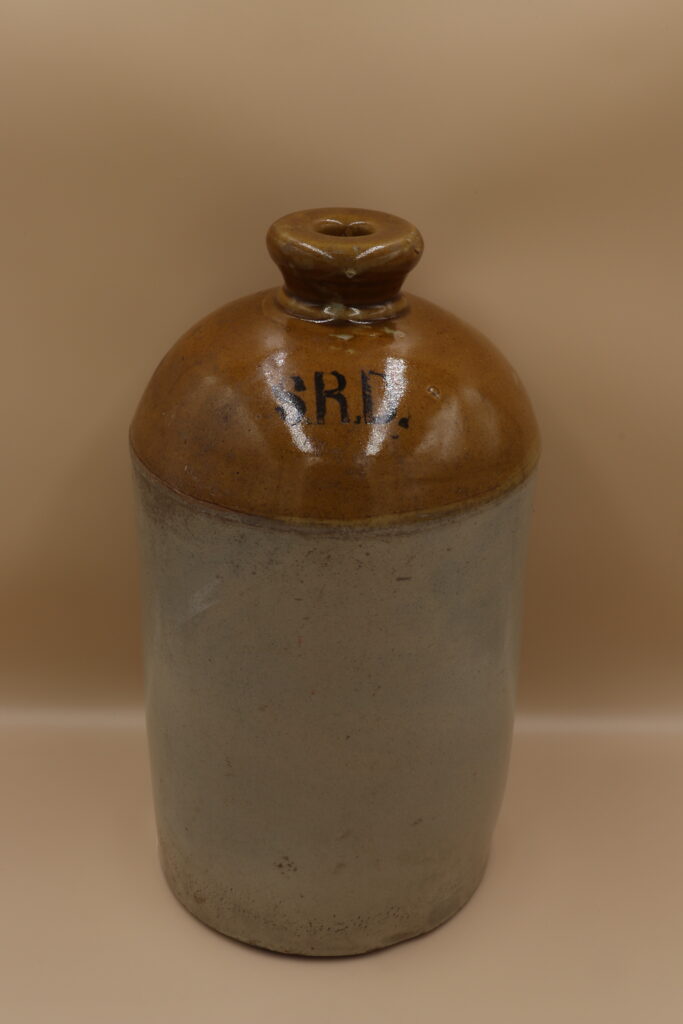
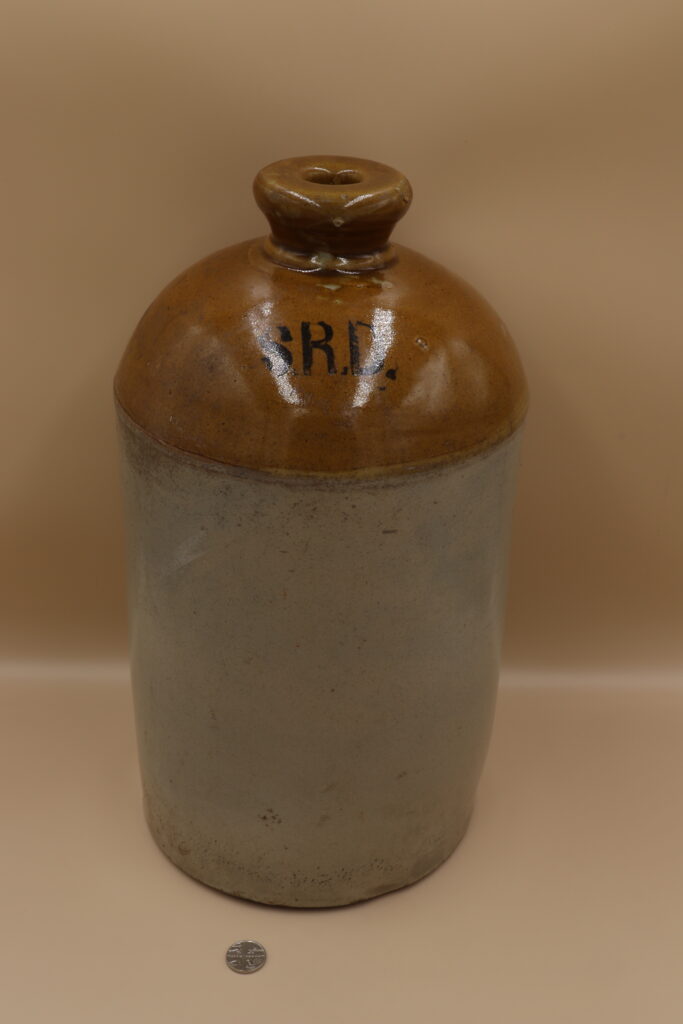

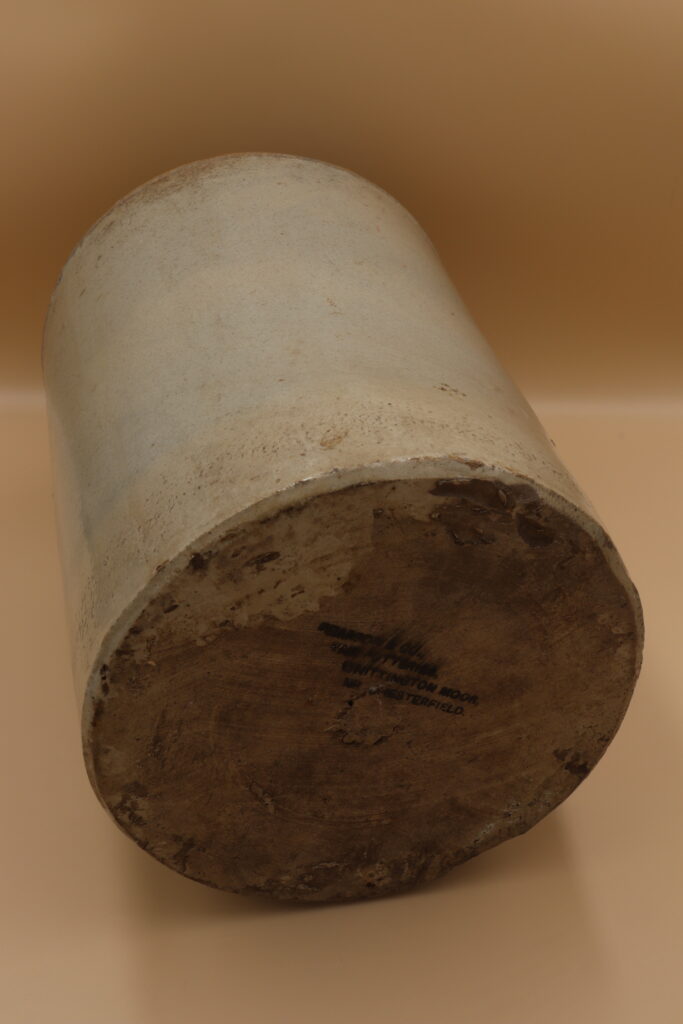
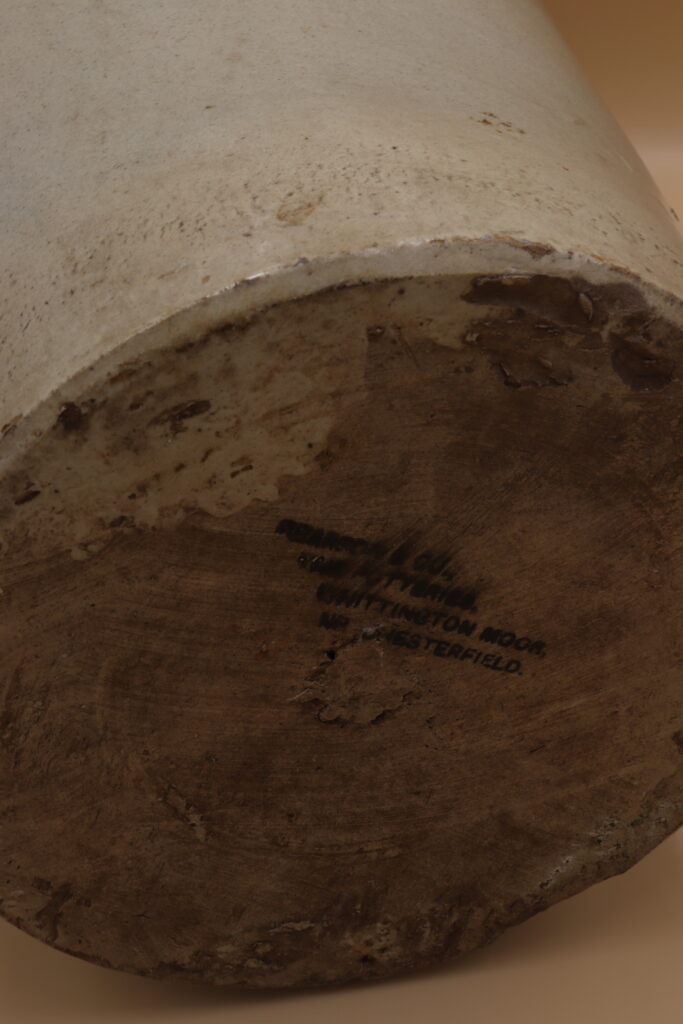
Item Reference: 006590
Category: First World War
Format: Artefact
Description: An oversize decorative board giving a roll of honour of Paris House, Chiesman’s buildings in Lewisham High Street. Paper roll with ink lettering in a large wood frame, glass fronted. Giving the names of those who served in chronological order with rank, unit, and decorations, and also whether wounded or killed. Bottom right hand corner features photographs of ten of those who died surrounded by patriotic cartoons.
Date: 1920s
Further Information: Cecil Stuart (C.S.) Chiesman, here a Captain, features in a later photo of the Second World War in our collection, then a Major commading the 5th Kent Battalion Home Guard.
Links: Long & Lazy Lewisham has written an extensive piece on this item, as well as another piece on recruitment efforts in and around the store. See also the Lewisham War Memorials entry.
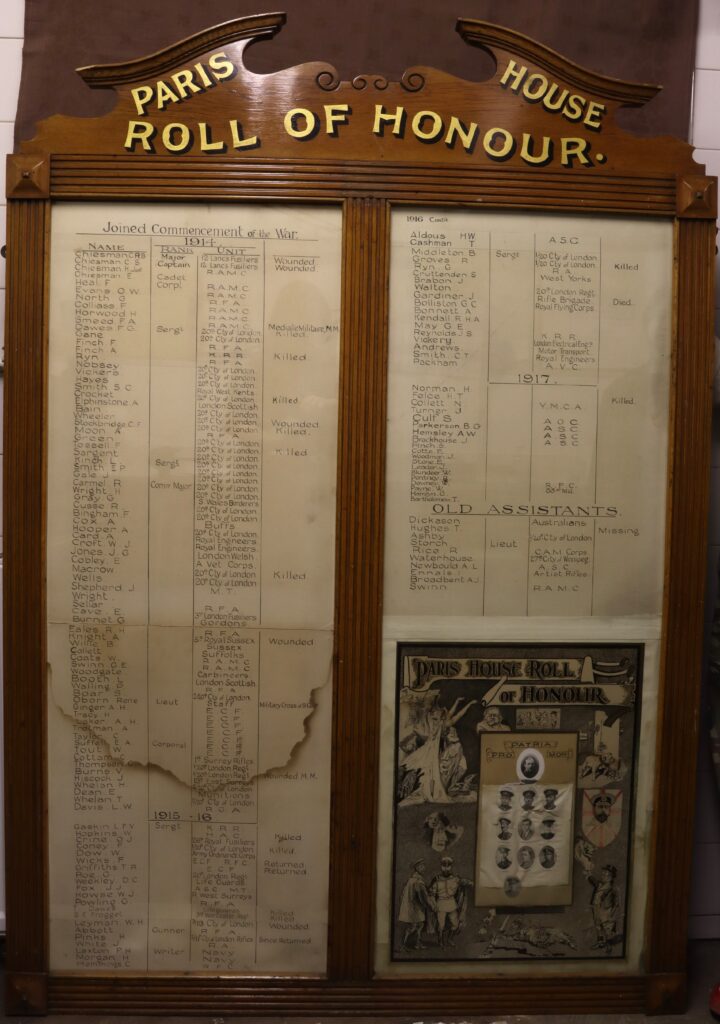
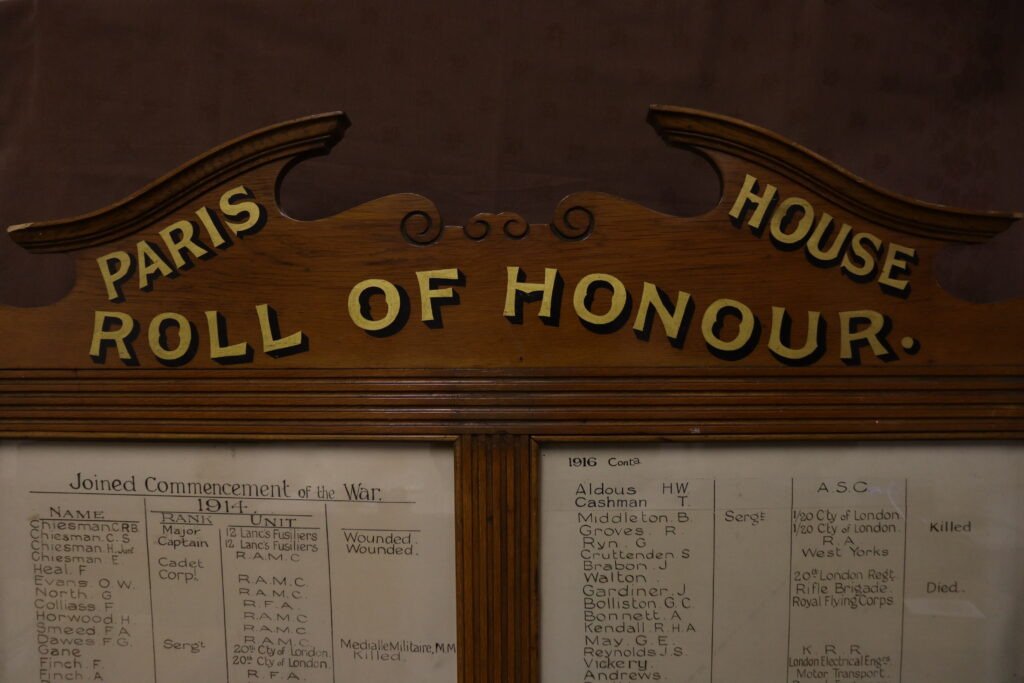
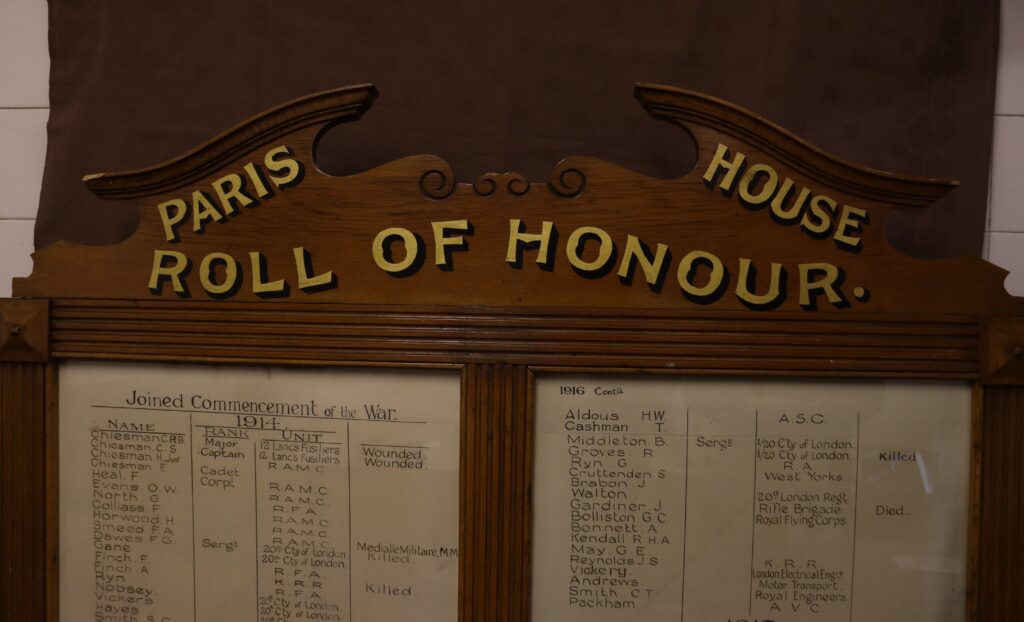
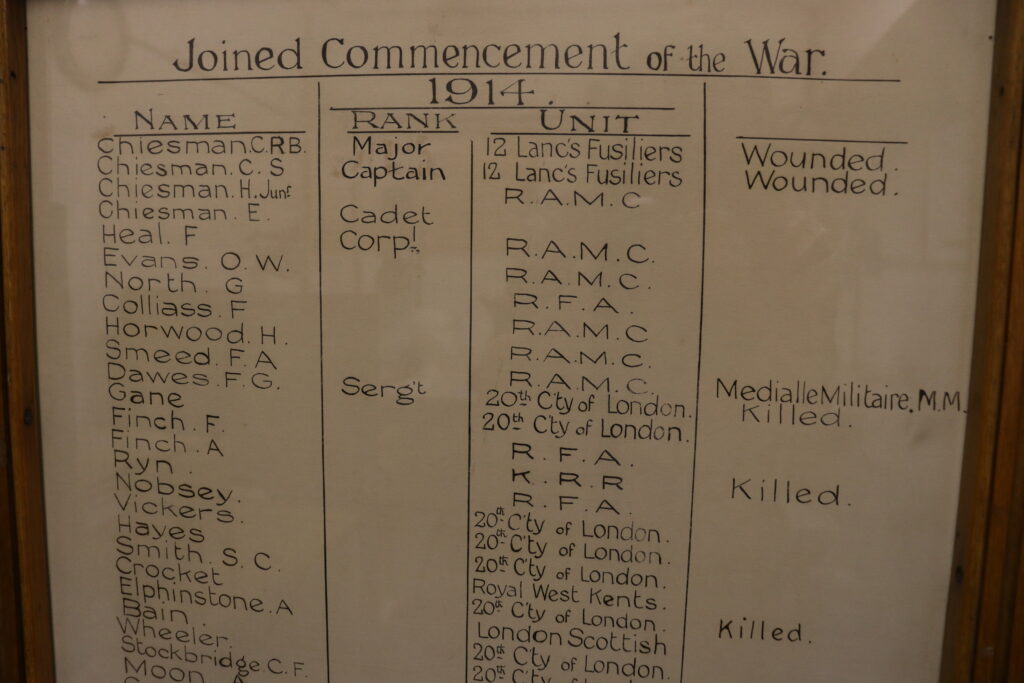
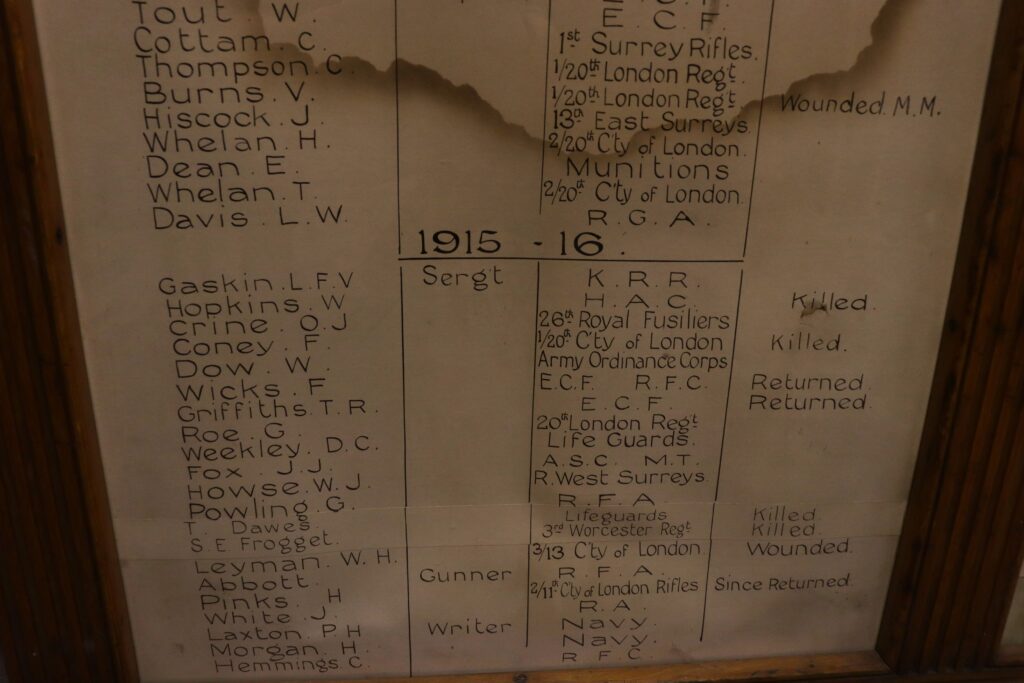

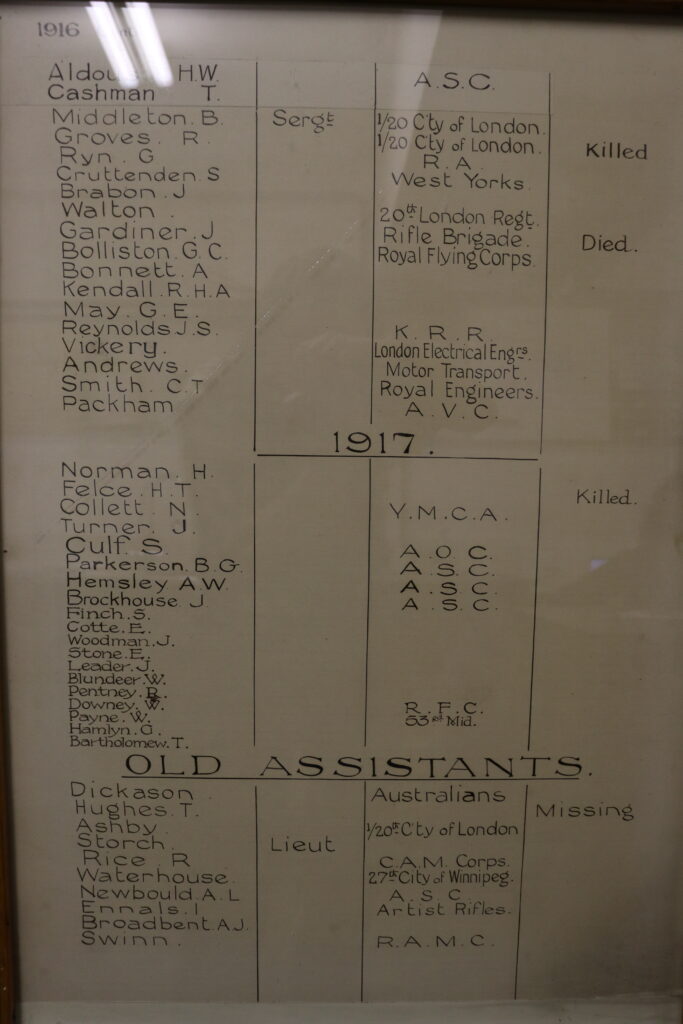
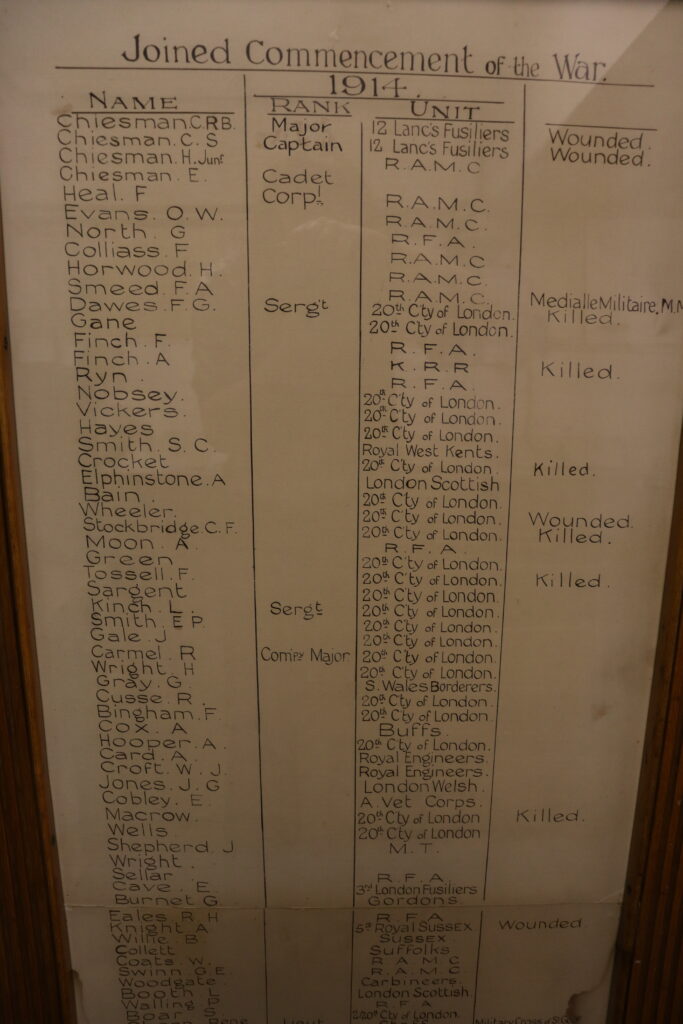
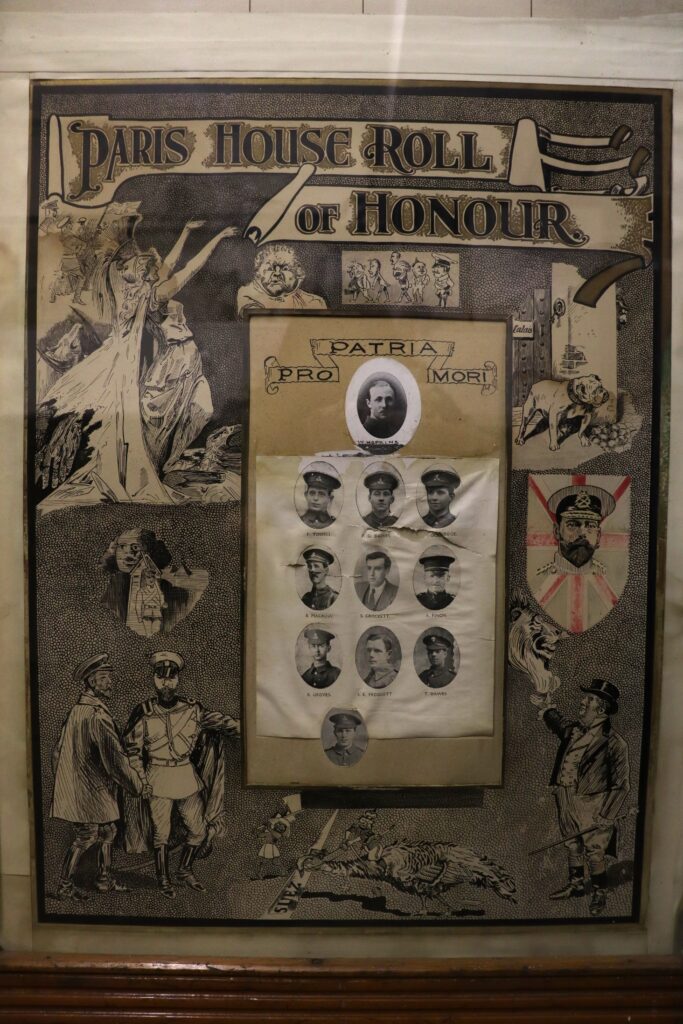
Item Reference: 006538
Category: First World War
Format: Artefact
Description: Decorative tin, originally containing a bar of chocolate, labelled, ‘Gift of the Colonies of Trinidad, Granada, St. Lucia to His Majesty’s Naval and Military Forces’
Date: 1917
Further Information:
Links:








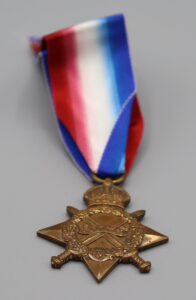
In this item spotlight we shall be focusing in on one of the more eye-catching items of our First World War collection. In their very nature medals attest to the heroic acts and exceptional feats of an individual’s life, and capture and cast these moments in metal to act as perennial testaments to such deeds. So too do they provide a window into otherwise forgotten lives and stories, or into that of the lived experience of generations past.
This medal is a 1914-15 Service Star, issued to all British and Imperial army personnel of all theatres of war who served before 31 December 1915 and who had not already qualified for the 1914 Star for service (specifically) in the British Expeditionary Force in the opening months of the war. Naturally, the 1914-15 Star was more commonly awarded than the 1914 due to the mass push of recruitment after the outbreak of war and the rapid formation of Kitchener’s New Army which was pushed into fighting in mid 1915. The medal was one of 5 campaign medals available for British soldiers of the Great War, which consisted of:
It was never awarded alone, always in tandem with the British War Medal (issued universally to all personnel) and the Allied Victory Medal respectively. This combination of medals was the most common, and, being issued in the months following the Armistice, together were nicknamed ‘Pip, Squeak and Wilfred’ after a popular 1919 cartoon.
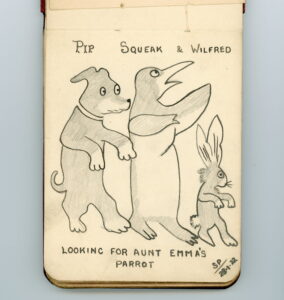
This in turn reveals another insightful disparity in the number of medals of each type awarded. Approximately 2.4 million 1914-15 Stars were awarded, compared to 6.4 million of the War Medal, which gives a clear indication as to the proliferation of British troops and personnel following the imposing of conscription in January 1916. The merit of the 1914 or the 1914-15 Star, then, was to demonstrate that an individual had volunteered to fight, rather than being forced into it. However, this is occasionally supposition as many still enlisted to fight even after the introduction of conscription, so technically volunteered.
On the reverse of the medal is an initially incoherent and intimidating string of information, one in a standardised language of lettering which needs deciphering. It reads as follows:
L.Z.-544.
S.G. Dadd.
LS. R.N.V.R.
The best way to approach this is to break it down and take each section individually to form a general image of the soldier in question. It all starts with a name: ‘S. G. Dadd’.
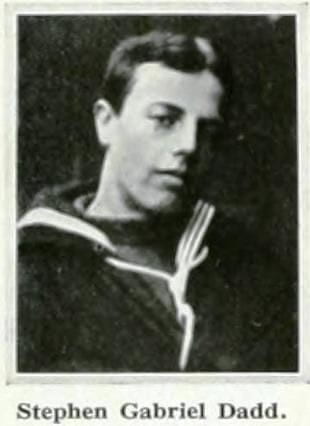
Stephen Gabriel Dadd was born on 17 May 1894 in Lewisham, the family then living on St Margaret’s Road in Brockley. The youngest of 3 sons and a daughter, Stephen was schooled at Aske’s Hatcham School in New Cross and later pursued art at Goldsmiths College. He showed notable talent as an artist and excelled at sculpture, so much so that in 1912 the 17-year-old had a bust of his sister Elfreda accepted by the Royal Academy. He had at least 3 more sculptures displayed by the Academy up to 1916. Much of his work gives striking depictions of animals which he used to study and sketch along with birds at the Zoological Gardens.
Prior to the war he earned a living as an art teacher and his artistic prowess is of little surprise when you consider the family he came from. His father, Stephen Thomas Dadd, was a painter who specialised in dogs but who also produced a multitude of images for newspapers. His Great-uncle was the famous victorian painter Richard Dadd (1817-1886), whose tragic yet fascinating life was defined by his schizophrenia and murder of his father, for which he spent the rest of his days in Bedlam and later Broadmoor asylum. Here he painted both orientalist and fantastical scenes. His uncle Frank Dadd was another celebrated artist who, amongst a plethora of other works, designed and painted the famous Veteran’s Farewell recruitment poster in 1914. His cousin Philip Dadd contributed many images to The Sphere newspaper, even whilst on active service in France, where he was killed in August 1916.
Let us then incorporate another aspect of the medal’s inscription. ‘LS. R.N.V.R’ tells us that Stephen G. Dadd was a Leading Seaman in the Royal Naval Volunteer Reserve, and so evidently served with the Navy at some stage in 1914-15. However, the last aspect of the inscription, specifically the ‘L.Z.’, adds both the necessary final piece for understanding who this soldier was at a glance, as well as providing an entry point into the wider specifics of their service and experience of the war. In this case, this story also provides a local link that emphasises the proximity and humanity of these experiences, and situates this local experience into a global event.
We already know that Stephen was in the RNVR, and thus one of the two prefixes of his service number, the ‘Z’, tells us that he was a soldier of the Royal Naval Division. Some regimental nuance exists here, so a deeper explanation is in order.
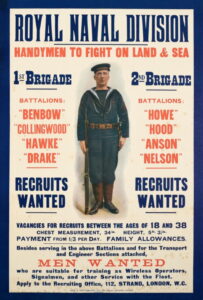
The outbreak of the war and the following call to arms saw an influx in recruitment to such a level that there was a surplus of recruits across the British military. For the Navy, the Fleet was already fully manned and so alternate arrangements were required for the some 30,000 surplus sailors for whom there were no ships to man. Therefore, the Admiralty (the body responsible for the oversight of the Navy) was tasked with finding a solution, which came in the form of the RND.
Formed on 16 August 1914, the RND originally consisted of 2 brigades, each with 4 battalions, all named after naval heroes. In the following month the Royal Marines were absorbed into the RND to form another brigade of 4 battalions. So, as of September 1914 the RND consisted of the 1st and 2nd brigades as well as a 3rd, often referred to simply as the Royal Marine brigade. The division as well as the sub-units within it would experience countless changes and reorganisation throughout the war, but for our purposes and for the part of the story that we’re interested in, let us take that as the structure of the division.
Winton Churchill then being the First Lord of the Admiralty, the new entity was derided as ‘Winston’s Little Army’. The labelling of them as an ‘army’ in particular would bring about umbrage; whilst they trained and fought essentially as an infantry force, and whilst they more often than not were organised under the Army rather than the Navy (particularly after 1915), the men of the RND staunchly considered themselves sailors, not soldiers, and embraced naval tradition and culture.
There was a further influx of men joining the division in early September when, under pressure from the War Office, excess Army recruits were instead offloaded onto the RND, prompting the establishment of a divisional depot at Crystal Palace, then still standing.
This leads us to the next prefix, the ‘L’. This letter correlated to one of the 7 divisions of the RNVR at the start of the war, all named after their respective regions and simplified to a single letter for administrative purposes around this time. The ‘L’ here stands for London. All recruits to the new RND would have been given this letter to indicate where they had joined up to the RNVR (the RND’s parent organisation), the ‘Z’, and allocated a number based on how many men had joined up at the same place before them.
In summary, from deciphering the lettering we know that Stephen G. Dadd joined up to the RND in London and was the 544th man to do so. His discharge papers (National Archives ADM 339/2/1089) show that he joined the Division at Crystal Palace shortly after joining the colours, though whether he enlisted here or at a recruitment post elsewhere in Lewisham is unclear. At the time there weren’t many other places to go to enlist in the borough.
The London Regiment had a battalion based in Blackheath, however this was completely a territorial regiment (forces for homeland defence). Many territorial forces did end up sending troops abroad, yet, in keeping with other territorial forces, the Blackheath battalion only dispatched ‘service battalions’ to fronts the following year and raised another after a recruitment push around Lewisham in spring 1915. Recruitment for a new Lewisham battalion as part of the Royal West Kent Regiment only began in May 1915 and failed to meet expected quotas. A fantastic 2-part account of both of these recruiting processes can be found here. Hence, it’s practically certain that Stephen would have enlisted at the Crystal Palace RND depot.
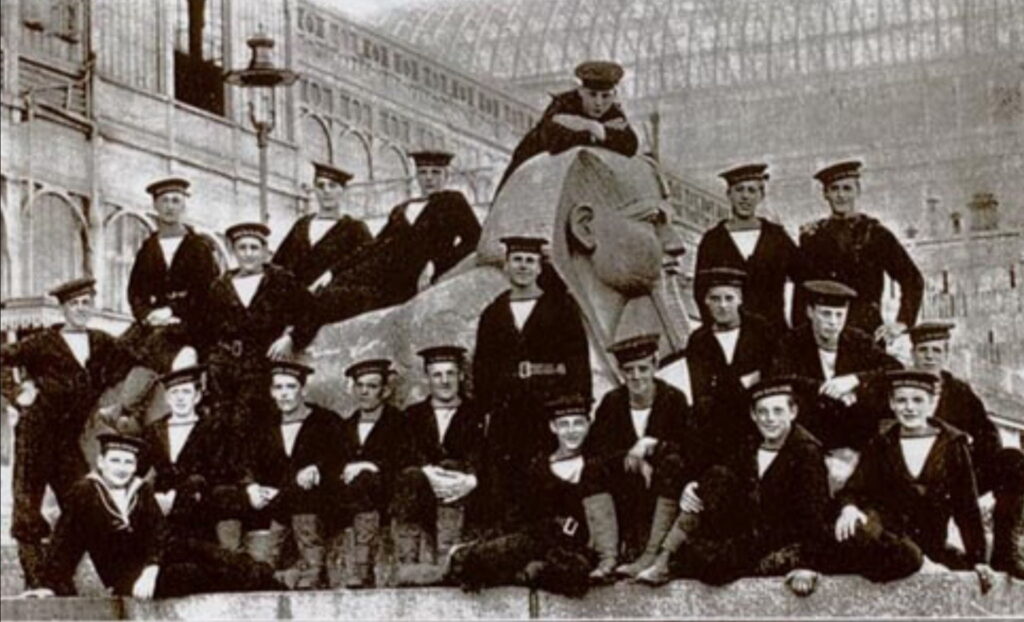
Given the timing, Stephen would not have seen service in October in the infamous defence of Antwerp which proved to be a disastrous first outing for the new division. It ended in supreme embarrassment when 1,500 troops (over half of the troops lost in the battle) were forced to retreat across the border into the neutral Netherlands where they were subsequently interned for the duration of the war. Churchill was mocked for the failure of his ‘little army’, a prelude to the later humiliation of the failure of the Gallipoli campaign. Rather, at this time Stephen would’ve been posted at ‘HMS Crystal Palace’ (as it was affectionately called), undergoing basic training.
With stalemate setting in on the Western Front and unfathomably extensive trench systems crystallising (figuratively and literally with ice) over the winter of late 1914 – early 1915, plans were devised to break the deadlock. One such plan was the idea of knocking the Ottomans out of the war, as a means of grand strategy to shorten the war in the long term, amongst other things. The Royal Navy were entrusted with the task of taking out Turkish defences along the Dardanelles (the Strait of Gallipoli) in order to clear a path to Constantinople, which the British and French naively considered an easy feat.
However, these hopes and the misplaced belief in the absolute supremacy of the Navy were quickly squandered, as the planned programme of naval bombardments did little to damage the Turks and only acted as a conspicuous forewarning to them that an broader attack on the Gallipoli peninsula was in the works. The plan depended on a naval breakthrough. With the last naval attempt to force open the strait on 18 March failing, it became clear that the task would have to be achieved on land, which necessitated an amphibious landing of an army on the Gallipoli peninsula itself. Furthermore, the Turks, anticipating this, now enjoyed a solid month to build up their defences before the first landing actually occurred at Cape Helles on 25 April 1915.
As a naval action ultimately under the command of Churchill, it was only logical that ‘his’ naval-infantry division be given a chance to prove itself once again. Given that an amphibious landing and joint naval-army action was expected of the forces fighting at Gallipoli, they were seemingly perfect for the task. This said, the RND were not actually part of the initial landings (as in they weren’t storming the beaches), though they were present. It’s difficult to track the movements of each brigade and battalion in this period, though a record of the movements of the Royal Marine Brigade at least can be found here.
A member of the RND did pull off one feat of immense value to the landing, a diversion under the cover of darkness in the early hours of the 25 April. Lieutenant Commander Bernard Freyberg of Hood battalion swam out alone to a beach off Bulair in the Cape of Saros (significantly further up the coast than the respective landings at Cape Helles and ANZAC Cove) and placed flares along the beach under fire, and swum back again. This successfully detained two enemy divisions there whilst the actual landings took place. Unsurprisingly from such an intrepid deed, Freyburg would go on to become one of the most decorated soldiers of the First World War, and later Governor-General of New Zealand.
The RND would come in to reinforce once beachheads were established, though the critical point of all of this is that Hawke, Collingwood and Benbow battalions, 3 of the 4 battalions of the 1st brigade, did not arrive until May. Stephen had been posted to Benbow battalion in March, which did not set sail for the Dardanelles until 17 May, Stephen’s 21st birthday.

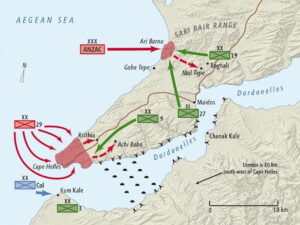
Three days after the landings, on 28th April, the British force at Cape Helles (now bolstered by French reinforcements from Kum Kale) attempted to advance up the peninsula in the First Battle of Krithia. At this stage it was still assumed that the Allied forces would win a swift victory once they managed to break out from their established footholds. However, the Allied assault failed to capture any ground, and by the end of the day the Ottoman defenders had pushed the attackers back to their starting positions. This came at a cost of some 3000 casualties of the 14,000 Allied troops involved (almost a quarter) for no progress made.
On the contrary, in an eerie echo to the same state of affairs on the Western Front, the lines started to set in and gave way to a following half a year of attrition battles in which the Allies made little to no advances before they finally evacuated, all at a staggeringly high, yet futile price in human lives. The fact that this was merely the ‘first’ battle of Krithia immediately reveals this to be so.
Ottoman counter-attacks on both Cape Helles and the ANZAC beachhead followed, but were repulsed. On 6-8th May, the Allied forces made another attempt to reach Krithia, but failed to make any meaningful gains for the 6,500 casualties sustained of a 20,000 strong force (almost a third of the allied combatants in the battle).
Hence, by the time that Stephen’s Benbow battalion reached Gallipoli in late May, the 2nd and 3rd (Royal Marines) brigades had already been battered and hardened by these two battles. Hawke, Collingwood and Benbow battalions did not reach Gallipoli until late May. Collingwood was immediately attached to the 2nd brigade to cover losses, a harbinger of the later mass re-organisation of the division in the months to come.
There exists no record (at least that I could find) of Stephen’s responses to his arrival in Gallipoli, nor to the sights he saw or the atmosphere he was greeted by. Hence we have to turn to a contemporary of his, a Thomas Macmillan, also of Benbow battalion. His account can be found as part of the incredibly extensive RND Journal, the relevant issue of which can be found here (see pages 776-804). Macmillan recalls the cold night in which they approached the peninsula, crammed onto cargo ships and forced to stand in the biting cold. He recalls the dawn they arrived on ‘V’ beach, the curious eyes that peered at the new arrivals from the multitude dugouts, the marching from the beach to their forward positions all while enemy shells flew far overhead, the digging in once at their battalion position using nothing but entrenching tools to make shallow shelters. He even remarks that his own dugout was much alike a “mummy’s coffin”, and offered no real protection at all. However, on a more wistful and human note, he also recalls the first night there where he struggled to fall asleep, not due to the distant gunfire on the front, which “never slept”, but as
“the stars in the heavens were so bright and attractive [that] the Milky Way had, for the first time, justified its name.”
We can only imagine Stephen in much a similar situation, in this odd mix of excitement, apprehension, but also impending dread, laying wondering about it all under the stars shining on a wholly unfamiliar landscape.
The reverie was not to last for long. Two days later Benbow’s camp was to receive its first bombardment, in which the youngest member of the group was killed, a bugler, a mere teenager. Shortly after, Macmillan’s company was called up to proceed to the front, and along the way a massive enemy bombardment opened up onto it. The company spread out and lay in wait, expecting a Turkish breakthrough, whilst men of the 2nd Brigade just wandered through and past them completely unfazed, heading also to the front. Eventually the passing men, already used to the fighting after only a couple months there, told the new company to “get up you bloody fools; there will be no break-through to-night [sic] or any other night.”
Neither the hardened 2nd and Royal Marine brigades nor the newly arrived 1st brigade were to fare well over the following months, to the point that the division was practically decimated by the fighting as well as atrocious conditions and rampant disease.
On 4th June the Third Battle of Krithia took place, in which both the 1st and 2nd brigade fought. This would have been Stephen’s first experience of battle. Once again, the Allied forces failed to decisively break through Ottoman lines, and in the end both sides were left at breaking point. The 2nd brigade had been part of the first wave, but when Collingwood battalion attempted to advance past the first objective their right flank was left exposed, and almost the entirety of them were killed by enfilading machine gun fire.
As Macmillan recalls learning at the end of the day, they had charged “into the breach, where they were enveloped in a curtain of fire, and of approximately one thousand men and twenty-seven officers who went forward only eighty-seven sound men and three officers answered the Roll Call.”
The RND did indeed advance, but could not hold their gains and were forced back to their starting positions within a few hours. It was much the same story all along the line.

After the battle, Benbow battalion was broken up and its troops transferred to various different battalions in need of reinforcements. Stephen was transferred to Anson battalion, of the 2nd brigade. The division would be further broken up when in early August the 4 battalions of the 3rd Royal Marines were so lowly manned that they could be reduced to 2, and were transferred to the 2nd brigade. In only 3 months of fighting, the division had been whittled down from a fighting strength of 3 brigades to 2. Stephen, however, would not live to see this…
On 5th July 1915, just over a month after he arrived in Gallipoli, Stephen Gabriel Dadd was killed in action. The Battle of Gully Ravine was closing on this day, and represented the last major attempt to break through Ottoman lines on the Helles front for the rest of the campaign. The RND were not part of this attack, though due to the nature of the foothold on the peninsula they were at most only a handful of miles away. The engagement in which Stephen was killed was part of the Ottoman counter-attack, of which a massive, final attempt to break Allied lines occurred this day, and was only narrowly repulsed. In the RND’s own records of casualties, a scene of that morning’s action is given by the Hon. K.R. Dundas and corroborates this:
It was “about 7am when I heard a sudden burr, & looking round saw the whole of our right bolting. Things looked pretty bad, but we charged out & reinforced the right, & drove off the Turks with heavy losses.”
Stephen was one of those losses. Listed as ‘killed in action’, nothing is known of the specifics of his death. Such things were often too gruesome for official records. De Ruvigny’s famous Roll of Honour provides us more details as to his perception by his fellow soldiers. Petty Officer William Arblaster said of Stephen that:
“He was in my platoon and was liked and respected by all, both by his seniors and by those he was in charge of (…) he was killed yesterday morning about 7 a.m., and was quietly buried in the afternoon.”
Stephen was originally buried in White House Cemetery, but was exhumed and moved to Redbout Cemetery into which a number of the grave sights around Krithia were centralised following the armistice. It remains his final resting place to this day.

Following this final burst of action, the lines around Krithia truly set in. Both sides were worn down and making no progress to their aims, and so ultimately the Allies abandoned any hope of advancing up the peninsula from the foothold around Cape Helles, and turned their attention elsewhere. The only other battle to occur here would be a diversionary action to distract from another landing at Suvla in August. Otherwise, the lines would remain the same until the Allies eventually abandoned the whole campaign and evacuated in January 1916. It had been a futile venture, and one that came at a staggering loss of life for even the smallest gains of a few hundred metres or less. Ironically, in the Allies’ desperation to divert from the stalemate on the Western Front, they had created a new theatre that came to resemble exactly the same deadlock along with all the same miserable trappings of industrialised trench warfare, on top of those of fighting in a tropical environment. Indeed, tropical diseases accounted for the majority of the casualties on both sides.
In total, roughly 55,000 Allied troops were killed in the campaign. Amongst this number, it is easy to lose track of the lost lives of individuals, which constituted the real toll here. This number, tragically, is not even considerably high compared to that of the horrifying battles of the Western Front, nor was Gallipoli even a particularly important campaign in the end, though we remember it potently in our cultural memory of the war. Simply put, in the face of such a colossal event as the First World War it can become easy to lose track of any individual’s life.
Whilst Stephen’s life, too, exists in the shadow of this event, thankfully he has not been forgotten. However, he is overshadowed in a more curious way too, as it turns out his brothers just so happened to know and interact with some of the most famous writers of the British side of the war.
The works of these writers are ultimately the accounts that have forged large parts of our cultural memories and contemporary understandings of the war. Stephen’s brother Edmund Hilton Dadd served in the 1st battalion, Royal Welch Fusiliers, and was friends with none other than Robert Graves. Edmund is mentioned frequently in Graves’ seminal biography of the war Goodbye to All That, though this is not all.
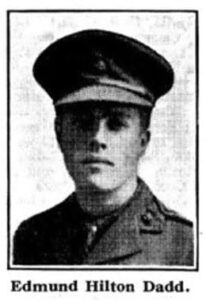

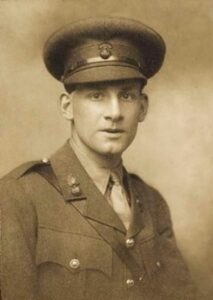
Edmund was also an officer in the same company as Siegfried Sassoon at one point, and furthermore the third brother, Julian Dadd, was in the very same company! Just as Edmund, Graves and Sassoon were both fellow officers and friends, Julian and Sassoon became particularly close. In a tragic coincidence, Edmund was killed and Julian badly wounded in the very same attack on 3rd September 1916, and even more coincidentally Graves and Sassoon (the former convalescing from near fatal injuries sustained at High Wood, the latter on leave) learnt of this at exactly the same time as one another. As Graves recalls:
“Siegfried bought a copy of The Times at the book-stall. As usual, we turned to the casualty list first; and found there the names of practically every officer in the First Battalion, listed as either killed or wounded. Edmund Dadd, killed; his brother Julian, in Siegfried’s Company, wounded – shot through the throat, as we learned later, and only able to talk in a whisper (…) still feeling very weak, I could not help crying” (Goodbye to All That, p. 237).
Sassoon would even write a poem entitled ‘A Whispered Tale’ about Julian’s inability to speak, and the two would stay in contact right up to Julian’s suicide in 1937.
This medal as a whole is a true testament to how far an single item can take you. Sometimes fantastic items lead to dead ends and otherwise commonplace items reveal amazing stories. This medal is a merging of the two: a flashy, interesting item in and of itself which reveals a spider’s web of connections with the past, the true extent of which is yet to reveal itself.
This blog post is derived from a larger body of ongoing research that I am conducting into the Dadd family, and represents only a fraction of the story that I have already compiled. I am in the process of writing this up into a larger piece for publication and, as such, any additional information would be greatly appreciated.
Jude Pretoria, BA History, Goldsmiths, University of London